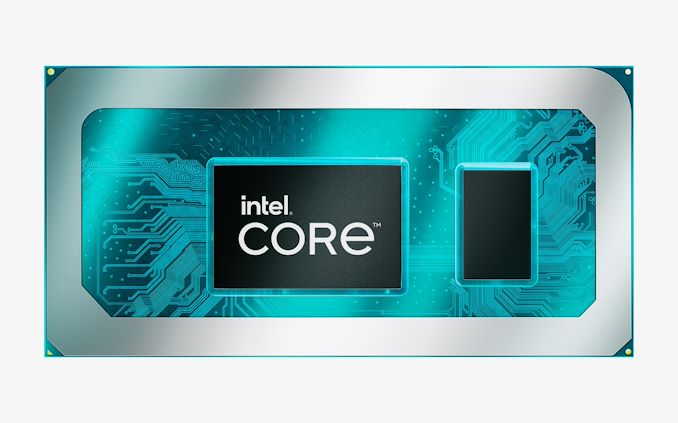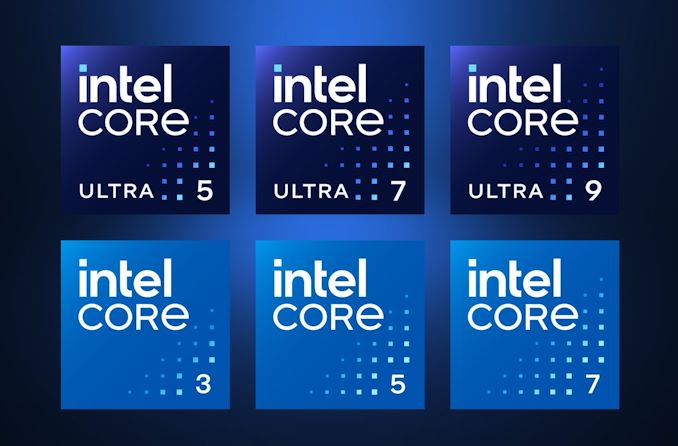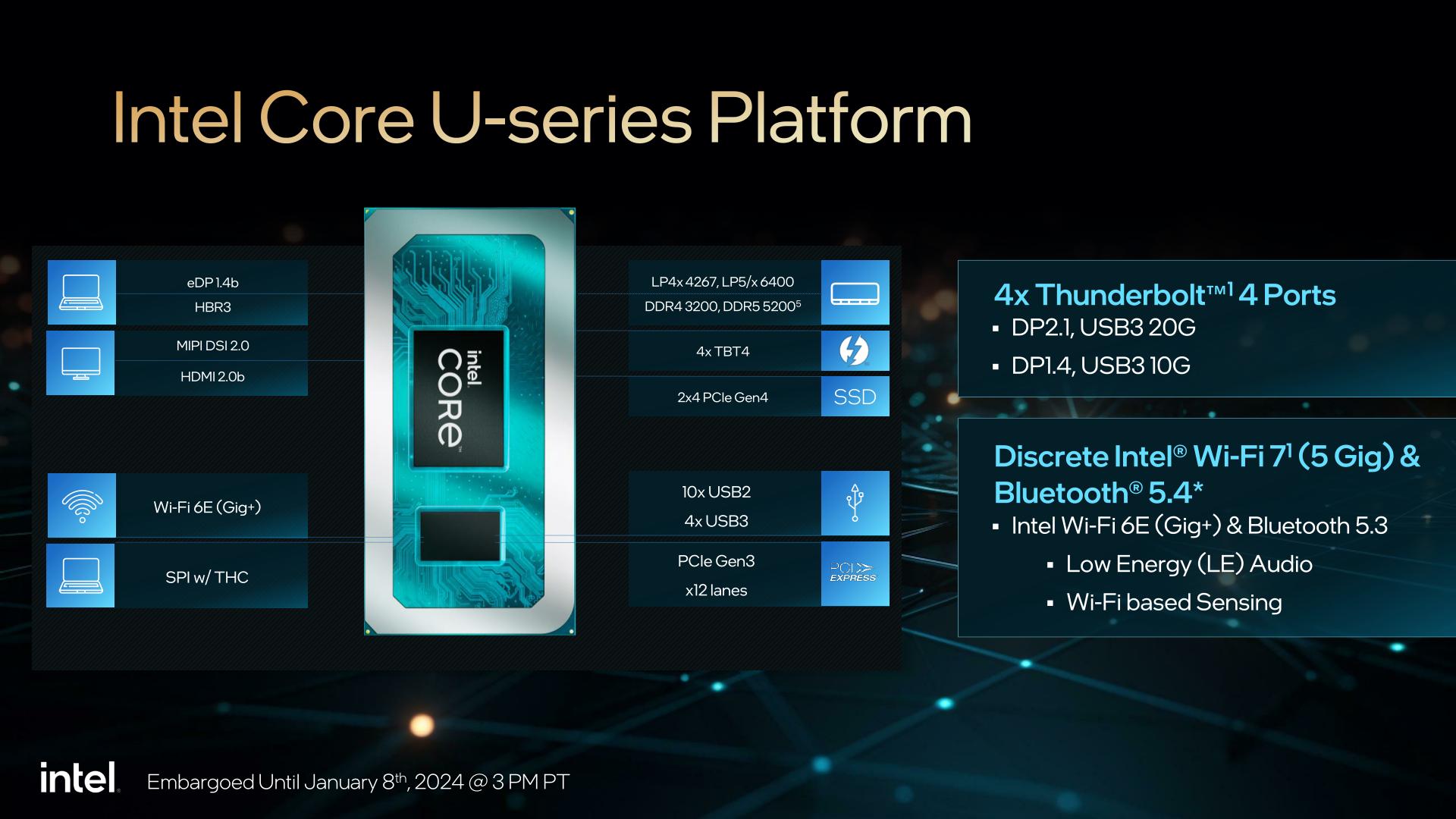Intel Intros Core (Series 1) U-Series Mobile Chips: Raptor Lake Refreshed for Thin & Light
by Ryan Smith on January 8, 2024 6:01 PM EST
Alongside Intel’s bevvy of 14th Generation Core product announcements for desktop and mobile today, the company is also releasing a collection of new SKUs under their new Core (Series 1) branding, aligning with Intel’s recently launched Meteor Lake architecture Core Ultra chips. Based on Intel’s existing Raptor Lake silicon, which was first introduced last year, the new Core U-series chips are aimed at the low-power thin & light notebook segment, and will fill out the Core chip lineup with a trio of cheaper parts using last-generation hardware.
Keeping things short and sweet, there are just 3 new Core U-series chips, covering the Core 7, Core 5, and Core 3 segments respectively. Under the hood there’s nothing here that we haven’t already seen before with the 13th Generation Core U-series processors, relying on a mix of Raptor Cove performance CPU cores, Gracemont efficiency CPU cores, and an Xe-LP integrated GPU. But these parts are clocked a bit higher than their direct predecessors.
Differentiating these chips from the newer Meteor Lake-based chips that Intel started selling last month, the new Raptor Lake-based Core chips are adopting the Core moniker without the Ultra. As outlined by Intel in their branding announcement last year, the new Core series branding has been split up into two tiers: a basic Core tier, and a Core Ultra tier. And with Meteor Lake chips occupying the Core Ultra tier for this generation, that leaves the Core tier for Intel’s refreshed Raptor Lake mobile chips.
| Intel Core (Series 1) U-Series (Raptor Lake Refresh Mobile) | ||||||||||
| AnandTech | Cores P+E/T |
P-Core Base |
P-Core Turbo |
E-Core Base |
E-Core Turbo |
L3 Cache (MB) |
Processor Graphics | Base W |
Turbo W |
Intel vPro |
| Core 7 | ||||||||||
| Core 7 150U | 2+8/12 | 1800 | 5400 | 1200 | 4000 | 12 | 96 EU | 15 | 55 | Y |
| Core 5 | ||||||||||
| Core 5 120U | 2+8/12 | 1400 | 5000 | 900 | 3800 | 12 | 80 EU | 15 | 55 | Y |
| Core 3 | ||||||||||
| Core 3 100U | 2+4/8 | 1200 | 4700 | 900 | 3300 | 10 | 64 EU | 15 | 55 | - |
Overall, the new chips are a direct reprise of last year’s Core 13xxU series parts. That means we’re looking at a single-package, mobile-focused chip with up to 10 CPU cores – 2 P cores and either 4 or 8 E-cores, depending on the SKU. The Raptor Lake Refresh silicon otherwise retains all of its marquee features, including integrated Thunderbolt 4 support, integrated Wi-Fi 6E support, 8 lanes of PCie 4.0 connectivity for SSDs, and support for LPDDR5(X) memory.
At the top of the new non-Ultra mobile stack is the “Core 7 Processor 150U”, or for the sake of brevity, what we’ll just call the Core 7 150U. This is a fully-enabled Raptor Lake Refresh part with 2 P-cores and 8 E-cores. The base frequency for the mobile chip’s P-cores is 1.8GHz, while the max turbo frequency is 5.4GHz and 4.0GHz for the P and E cores respectively. Meanwhile the integrated GPU has a maximum clockspeed of 1.3GHz. Altogether, this is a very modest boost in clockspeeds over the previous-gen i7-1365U, which topped out at 5.2GHz/3.9GHz.
Notably, however, Intel hasn’t given us much in the way of information on the integrated graphics ahead of today’s embargo. The iGPU on these parts will not carry the old “iris Xe” or “UHD” branding; instead, everything is now just “Intel Graphics”, in-line with how iGPU branding on Meteor Lake chips works. However, that also means that it remains unclear whether the Core 7 150U is using a full 96EU configuration, or something cut-down. We’ll have to wait to see what Intel posts on Ark in the coming days. Update: And the configurations have since been confirmed. 96, 80, and 64 EUs respectively, all under the same brand name.
Moving on, the next chip in the lineup is the Core 5 Processor 120U. The 120U is still a 10 core (2P + 8E) configuration, and the differences from the Core 7 chip boil down to clockspeeds. Here the base frequency for the P-cores is just 1.4GHz, while the P and E cores turbo up to 5.0GHz and 3.8GHz respectively. Based on how Intel handled graphics on the last-gen Core i5 parts, the iGPU is likely cut down from what’s found on the Core 7 part, but to what extent we don’t know.
Rounding out the trio is the Core 3 Processor 100U. The runt of the litter, the Core 3 100U does see some CPU cores cut, along with some other feature differences. Specifically, one of the E-core clusters is disabled on this part, leaving the chip with 6 CPU cores: 2 P-cores and 4 E-cores. The P-cores have a base frequency of 1.2GHz, while the turbo clockspeeds are 4.7GHz and 3.3GHz respectively for the P and E cores.
Notably, here, the 100U also loses some of its memory bandwidth. This chip is capped at just (LP)DDR5-5200 transfer speeds, regardless of the memory type used. The chip also has less L3 cache overall, so there’s less cache to backstop that slower memory. Finally, this SKU is the only member of the trio that is not Intel vPro capable, which will serve to limit enterprise interest in the part.
Otherwise, in terms of power ratings, all three chips are equal. And for that matter, are identical to their predecessors. Intel has assigned these chips a base power rating of 15 Watts, while the maximum turbo TDP is 55 Watts – with OEMs free to tinker in there as is necessary. So unlike the Core Ultra lineup, there are not any ultra-low power (30W) SKUs here, leaving ULP as the domain of Intel’s premium chips.
The physical chips themselves are also unchanged from the last generation. Intel’s stock photos and diagrams show them using the familiar BGA Type 3 packaging here, with the CPU and PCH both on the chip package.
And while not strictly a feature of the platform itself, Intel has indicated that we may see some laptop vendors ship Raptor Lake Refresh laptops with Wi-Fi 7 capabilities instead. In those cases, those laptops will be using a fully discrete Wi-Fi controller.
Finally, it’s interesting to note that with today’s announcements Intel is addressing the very top (DTR-class) and very bottom (thin & light) segments of the mobile market, but they haven’t introduced any Raptor Lake Refresh Core parts for mid-performance mainstream notebooks (H/P-series). Intel’s new branding system certainly leaves the door open to that, and while nothing is being announced today, the current non-Ultra Core product stack leaves an obvious hole for Intel to fill at a later time with more Raptor Lake Refresh hardware.
Wrapping things up, Intel tells us that we should see systems land sometime this quarter. Being that these are OEM parts, Intel isn’t releasing any pricing guidance, but we’re not expecting things to be much different from 13th Generation Core laptop prices.
Source: Intel













1 Comments
View All Comments
Unashamed_unoriginal_username_x86 - Wednesday, January 10, 2024 - link
This is (series) one of the silliest branding changes in the last few years, it doesn't feel malicious or intentionally confusing it just sounds *bad*